The natural year in Dol
This week: The Mediterranean climate; January; February; March; April; May; June; July; August; September; October; November; December;

“Time is relative…” said Albert Einstein. Here we are at the start of 2021, the year that the 21st century becomes an adult.
New Year is always a time to look forward, to make resolutions which are swiftly broken but also to take stock of accomplishments.
Almost everything I do in the garden and orchards is based around the natural seasons we experience here in Dol. The rhythmical, cyclical changes month by month; the movement from winter, through a brief spring into a long summer, short autumn and back to an even shorter winter.
I thought it might be interesting to update a blog post from five years ago and delve more deeply into the changes I see here every day.
The Mediterranean climate
The classic Mediterranean climate is recognised as being one which is characterised by cool wet winters and hot dry summers. However in this period of climate change we are experiencing, nothing is certain any more.
The weather patterns over the past six winters have each been completely different.
Indeed the weather during each year I have lived in Dol has been different to the previous one.
The 2015 / 2016 winter was dry, with half the rainfall of the previous year. April 2016 saw record temperatures world wide, whilst in Dol people were talking about summer having arrived early.
The start of 2017 was bitterly cold, when more than 1,000 water meters, including mine, froze and burst.

Then in February 2018 there was a “once in 50 year event” – snow.

Because of the weather worldwide, during 2020 has been recognised by the WMO as one of the warmest years on record.
Whilst here in Dol we had unseasonably warm weather right up to the end of October.

The average maximum and minimum temperatures recorded at my weather station look like this graph. However my experience is that recently the actual and the average can be several degrees adrift.
With the last day of 2020 behind us, my pictogram analysis of average temperatures for Dol Sv. Ana is complete and this is what it looks like.

Two parts of one village
Seen from above and looking west, Dol appears to be sitting in a natural amphitheatre in the shape of a letter “W”. St. Michael’s Church is in the centre, on a high promontory dividing Dol Sv. Maria and Dol Sv. Ana.

To the west of the Church is Dol Sv. Maria and to the east Dol Sv. Ana. Known as the “first Dol” and “second Dol” to locals. Most of the houses are built on either side of the 100 metre contour line with St. Michael’s at 120 metres.

The surrounding tree covered slopes create micro climates, known as thermal belts. These warmer, sloping areas of the village, away from frost pockets, allow tropical plants to grow.
Many sub tropical plants enjoy these isothermal zones. Date Palms and Cycads are to be seen growing as ornamental trees. On the opposite side of the hill to me, there are banana trees.

January
Siječanj – month of cutting or hewing (wood)

As the new year dawns, it is not many days into January before there is a noticeable increase in daylight hours. On the 1st of January, the sun climbs above the karst limestone ridge that runs the length of the island to illuminate St. Michael’s church at 8 am.
This is some 40 minutes after the official time of sun rise. It will be almost 9 am before the sun touches all the houses of the village, including mine.

Those few deciduous trees which line the roads shake and their dried leaves rustle in the wind. New buds begin to swell.
In Dol, our year-round butterfly, the Red Admiral is frequently seen flying and basking in the sunshine on warm January days.

It is the time of year when local people start the annual chores. Large rotavators are brought out of storage and lubricated. They can be heard chugging away, turning the soil in vegetable plots, burying winter weeds and generally tidying up.
Early vegetable seeds are planted and the Olive trees are pruned and fed. This is so that the winter rains will wash the fertiliser into the soil around the tree’s roots.

The birds start their courtship rituals and as the lengthening days and warming soil reawakens all life, so another year in Dol begins.
February
Veljača – the month in which days become longer
At different times of the year, there will be many different trees and shrubs in blossom.

At the very start of spring, in late January if the weather has been mild, the Almond trees shimmer with their pale pink and white flowers. They are the first trees to bloom, when other deciduous trees are completely bare.
In cooler winters it can be the end of February or early March before the blossom show is in full swing.

Many gardens along the roads have Mimosa bushes, Acacia dealbata. If you are on the roads and tracks around the village, you will see them, covered in delicate mustard yellow blooms which seem to light up the shrubs.
I have a Mimosa which is in the corner of the Drupe orchard, from where it can be seen from the old donkey track which leads up to St. Michael’s Church.

In some gardens and small orchards there are plum trees which will also be covered in blossom.
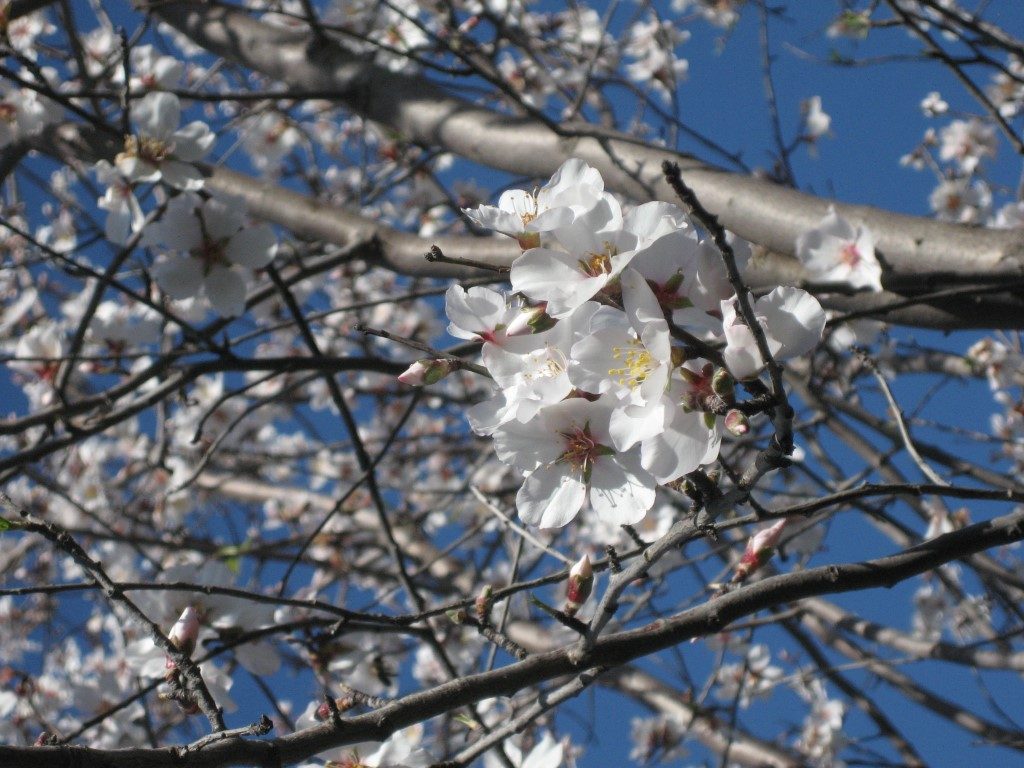
February is maintenance time for the many thousands of vines. The land’s owners move quickly along the rows of vines, pruning out last year’s spurs.

March
Ožujak – lying month (laž>ož; laž = a lie), because the weather is changing often
By the sides of the roads and in the olive groves, swathes of small pink Cranebills, Geranium tuberosumn are in flower, a perennial carpet on the floor.

Throughout March the number of flowers visible along the paths in the villages steadily grows as the strength of the sun increases and the daily temperature climbs.
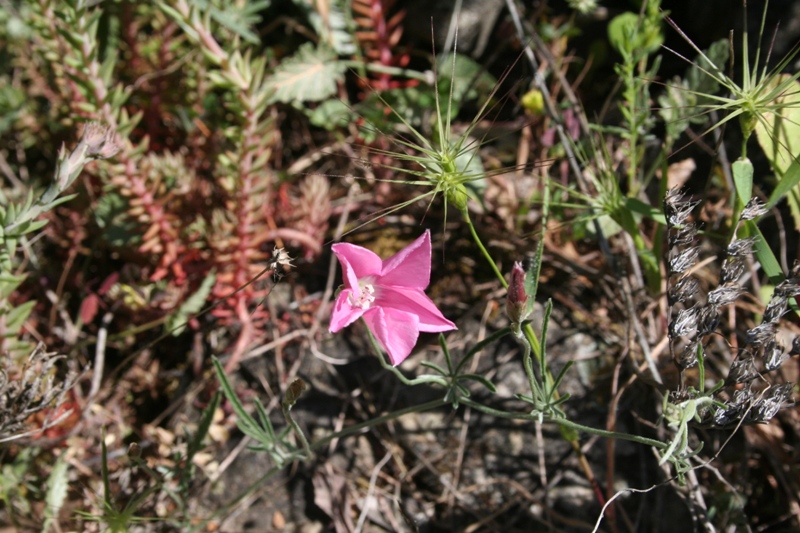
There are the common wild flowers like Daisies, which have been in flower all winter, but also less common varieties.

At home, the first buds appear and start to swell on my grape vines.

There is still plenty of work in the vineyards and olive groves. There are no prizes for the best turned out, just the owner’s satisfaction, knowing that he or she is ready for the year ahead.

In March while pests are still dormant, fruit trees have to be sprayed against insect infestations. Here peach trees have turned blue, but not with cold…

The end of March is when we hear and see our summer avian visitors. Most people know the Swifts and Swallows, but there are the Golden Oriole, and perhaps our most colourful annual summer visitor, the Bee Eater.

I have recorded hearing the Scops Owl regularly in March, with it’s distinctive “ping” call.
Easter which can fall in March or April, is when the first of the human visitors usually arrive. Although because of COVID restrictions and an early Easter in 2021, there may only be a very few.
The guest houses and apartments will have all been spring cleaned. Everything will be ready in a normal year, to welcome a steady stream of new faces and returning guests.
April
Travanj – the month of grass growing
April is a time to enjoy the profusion of wild flowers by the footpaths and green lanes.
Many different wild flowers can be seen wherever in the village you walk.
These including several varieties of orchid.

Wild flowers and grasses are in a race to develop, flower and set seed before the heat of summer and lack of rain stops all growth. At the same time the grapes vines also come into flower.
The vine flower buds swell and expand into small cones, growing daily.

Then these tiny, insignificant flowers develop into the plump grapes, for local tables or more probably for wine.

Ladies can be seen carrying arm fulls of wild asparagus that they have picked from around their home.
The purple spears appear all over, around buildings, on any piece of uncultivated land and beside the paths.

The first of the new generation of insects also become visible. Resplendent in their breeding finery and before the ravages of mating, weather and time dull their colours.

These are Scarlet Lily beetles, Lilioceris lilii, which area easy to spot and chew on my Madonna Lily leaves.
Reptiles also begin to emerge from their hibernation and bask in the warm spring sunshine.

May
Svibanj – month of budding (svibovina = Cornel tree)
By May the olive trees will be in flower.

Bearing tiny white half round shank button flowers, the different varieties of olive tree come into flower at slightly different times, making some trees look as though they have a covering of cotton wool buds.
Someone walking on the lanes around the village can find themselves surrounded by small clouds of multi coloured butterflies, seeking nectar from wayside flowers.

The deciduous trees are now dressed in verdant green, vivid against the azure sky.

It’s also the start of the first crops of fruits in my orchards. Strawberries and raspberries are ripening and the first flowers of summer, the Madonna lilies, Lilium candidum – a Balkan native species, are in flower along with Yellow Flag and iris.

The warmth of the sun has also heated the sea enough to make it comfortable to swim in.

June
Lipanj – month of the lipa (lime / linden tree)
In June the Linden or Lime trees burst into blossom.

You will often hear the tree before you see it, such is the cacophony of sound from the thousands of bees and other insects which are feeding on the nectar and pollinating the flowers at the same time.
The diminutive flowers would be almost invisible, were your attention not drawn to them by the insect noise and the sweet scent that they give off.
The noise is generated by the thousands of bees gathering nectar .
It is also when I harvest my plums – in a year when there has been no frost at blossom time.

Because the plum trees come into blossom very early, one late cold night at the wrong time can kill all the developing fruit.
The sweet golden fruits weigh the branches down and I gather them in buckets.

Their uses are many, but preserving in Kilner Jars for winter pies is one task. The round, yellow fruits are sweet and juicy and can be eaten straight from the tree.
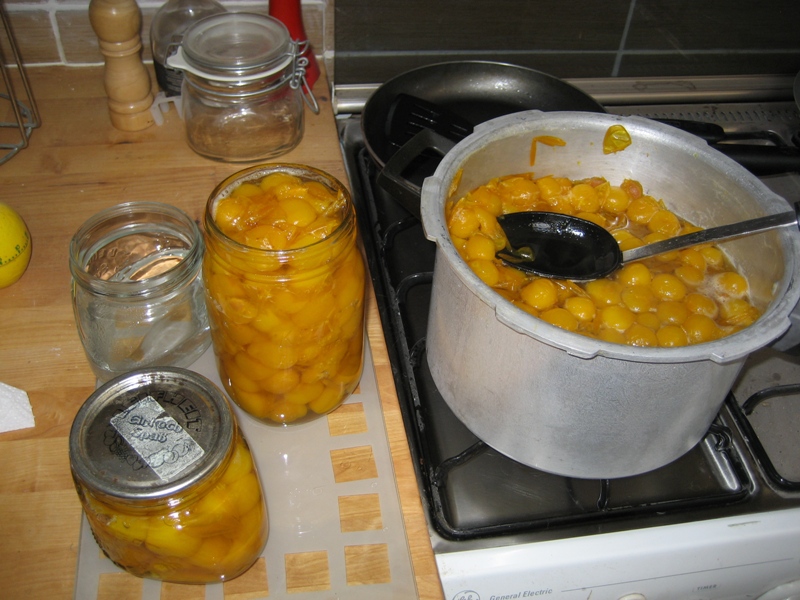
All around the village, the flame coloured flowers of the Šipac can be seen covering trees. They are often at the margins of fields, in gardens and by the side of roads and tracks.

There are a profusion of the early butterflies, feeding on things like the Buddleia I have planted. Caterpillars also become visible.

It is also the month of the longest day, when the sun rises behind the Dinaric Alps on the mainland and in Dol we see the sun sink into the Adriatic sea at sunset.


July
Srpanj – month of reaping (with a sickle)
By the first days of July the heat of summer has arrived and many plants have gone into their summer period of dormancy. The grass along the village paths and lanes is now dry and brown.

The true Mediterranean climate is characterised by being a winter cool and wet and a summer hot and dry.
However, the island of Hvar is close enough to the continental land mass of the Balkans to be affected when a cold Bura wind blows from the north east. This wind seldom lasts for more than a day.
In the higher northern latitudes, native plants go dormant and regenerate over the winter. Mediterranean climate plants avoid the heat of Summer by the same mechanism, bursting into new growth when the late autumn rains arrive.
The Circadas have hatched and their chorus lasts from dawn to dusk.
Then each evening, as their trilling ceases, it is replaced by the Cricket chorus. That familiar background sound of the warm Mediterranean night.

A daily Siesta is de rigour for everyone and everything.

It is also the time when the warming seas generate fierce but short lived thunderstorms. These bring quenching rains to a parched island, regenerating all living things.

Fig trees abound everywhere in the village. From the middle of July, the ripe fruits start to be harvested, plump, sweet and juicy.

August
Kolovoz – month of driving the wagon (for harvest) — kolo + voziti
The long hot summer days dry even hardy grasses, turning the sides of the roads and paths to brown.
At the start of the month the village holds its annual festival, the Puhijada. Named after the Puh, our Edible Dormouse, Glis glis.

For a week there are exhibitions and oratory, and sports in the shape of the Balota open championship.
Then on the last night there is a BBQ and party on the square until dawn. The village comes alive for a musical extravaganza and the publication of the village magazine, Tartajun.

The spring flowers have gone to seed, with just a few rugged Wild Carrot plants, Daucus carota, still in flower alongside their magnificent seed umbel.

All the indigenous plants become dormant in the summer, while the non-natives struggle and show signs of extreme stress caused by the lack of rain.
Just a few of the most persistent wild flowers with the longest tap roots still remain green. Often these will form a mono carpet.

In the forest glades the air is thick with the fragrance of pine resin, released from the trees by the summer heat. All the while someone is there, the air is filled with the sound of the chirping cicadas.
Not much is in flower in August, with just a few shrubs that have adapted to the conditions. These tend to have grey, leathery leaves and few stomata and they can be seen along all the paths.
Wild figs are ripening and ready for picking along the green lanes.

From late August large, sweet blackberries can be gathered from briars which emerge from walls alongside the old village tracks.

In a good year, when the weather has been kind, the middle of August will be when the first of the season’s grapes are harvested.

Everything (and everyone) is looking forward to the arrival of the cooler autumn weather and life giving rains.
Some of our most noticeable summer visitors, the European Bee Eaters, magnificent Golden Oriole and Scops Owl have departed along with the Cuckoo, starting their long and hazardous migration south to avoid the European winter.

The diminuitive Scops owl is a diurnal hunter and is generally only heard but seldom seen.
Its call, resembles the time “pips” injected electronically into radio broadcasts.
From dusk to dawn, different birds can be heard calling and answering around the village every night.

The Swallows have raised their second broods and are still wheeling around the village skies, but it will not be long before they too leave for Africa.
September
Rujan – month of animal mating (from archaic verb for animal roar “rjuti”, referencing mating calls)
In September, the high pressure system which dominates the weather over the Balkans and eastern Mediterranean during most summers, preventing Atlantic depressions from bringing rain, has started to weaken.
The first autumn rains trigger the rapid growth and flowering of autumn bulbs along the sides of the paths and in open woodland.
There is feverish activity in the vineyards to pick the grapes when they are at their optimum sugar content. The growers are anxiously watching the weather. Rain at the wrong time can devastate the harvest, as can cool weather.
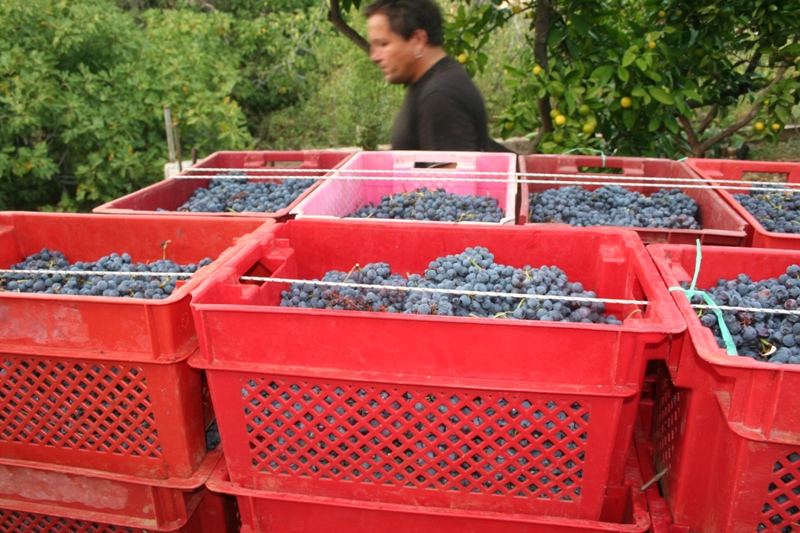
There are several varieties of grapes locally under cultivation and they become ready for picking at different times.
Suddenly the roads are quiet. There are lots of parking spaces in the car parks and the ferries which connect the island to the mainland revert to their autumn timetable with half the number of sailings.
October
Listopad – month of falling leaves — list + padati
Through into October there is a noticeable and accelerating change in the colour of the vine leaves in the fields around Dol.

At the same time, the bunches of late variety grapes start to show, plump and shiny through the foliage as it turns to gold and bronze.
Along the forest rides, look for the Strawberry tree, Arbutus unedo, with its small, dark red fruits.

The few hardy wild flowers that have survived the summer, together with the shrubs which line the paths are showing their seeds and fruit.

The tall yellow flowers of the Jerusalem artichoke, Helianthus tuberosus, are in evidence by the side of several paths and roads.

The spiny and multi-trunk Pomegranate trees, Punica granatum, can be seen with their large, round and ruddy brown fruit, begging to be picked.

Almost all of the summer visitors, both avian and human have departed, leaving just the locals.
November
Studeni – the cold month
As autumn progresses the processing of the grape harvest is in full swing and by November, a start has been made on the olive harvest.

The smell of wood smoke fills the air as people light their stoves to provide warmth on the rapidly cooling nights. Bonfires burn the tree prunings.

Occasionally in hollows “Jack Frost” will touch the leaves of trees, turning them to burnished gold, lit by the lowering autumn sun.

Towards the end of the November, the locally grown citrus fruits start being picked. In my orchards I have oranges, lemons, limes and mandarins, some grapefruit and the fabulous persimmon.
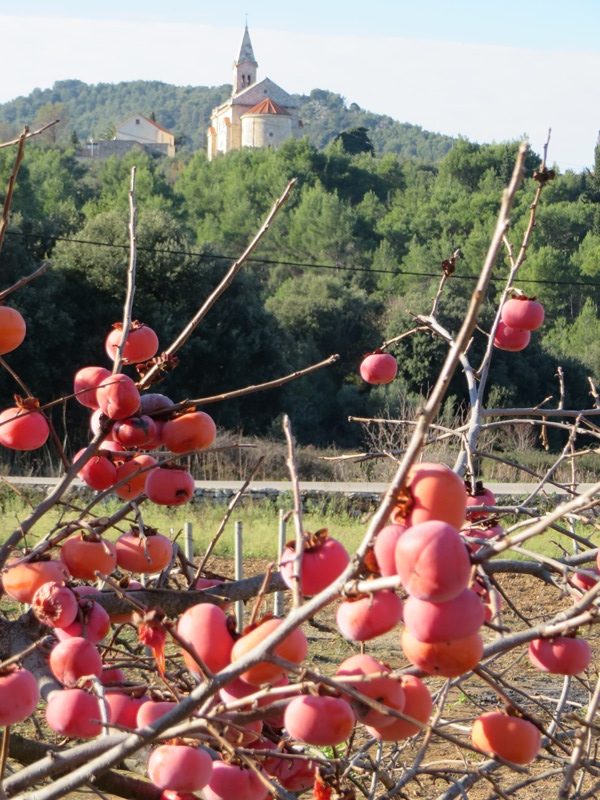
Oranges and lemons can be seen weighing down the branches of the trees in a good year. Along the paths and byways the grasses, sedges and lichens are still growing.

December
Prosinac – the beginning of the Sun’s shining
In early December wheat is planted on the Feast of St. Lucy, with a competition to see how tall it has grown by Christmas Day, when it will be placed in the centre of the luncheon table.

The sun is at its nadir, with some parts of the village seeing sunlight for just 5 hours, before it sinks by early afternoon behind the trees which blanket the southern hills.

The days are cool and the nights turn cold.
Sometimes at dusk you see an Eagle Owl, Bubo bubo, perching at the top of a pine, or flying silently over Dol. All through the winter, it can be heard calling with its long, lonely “Boo, Boo” call.
The annual Christmas tree will cut in the forest, to be erected in the main square in Stari Grad.

In the week before Christmas there will be forays into those same woods to gather the trees, lichens and grasses used to create the nativity scene, the centre piece of Christmas in each home.

A very old traditions takes place on Christmas Eve.
A special log, the Badnjak is selected and cut by local families in the forest and then brought home.
It will be placed on an open fire in the house during the evening and left to burn until Christmas morning.
The Croatian Christmas greeting, is Sretan Božić.
The last remaining leaves on trees in my garden turn yellow, then gold before falling to the ground.
From all around the base of the trees, the fallen leaves will be gathered up and taken to the compost heap. Or some will just be left where they fall, to enrich the soil.

Although the clock moves inexorably towards Midnight on December 31st and the fireworks which will herald the New Year, in Dol the cycle continues as it has for eons past and will for eons into the future… NCG

3 Responses
Steve
Happy New Year. Have a great 2021. All the best. Victoria and Steve
John Bailey
A lot or work went into this blog Norman. Photographs do make it a lot more interesting . Happy New Year. Look forward to following your progress in 2021. Keep safe. John.
Marcy Fletchall
Happy New Year Norman. What a wonderful blog. I enjoyed every bit of it and can see the work put in for the story and pictures. I really enjoyed learning about the annual events and nature at that time in this blog. It was so well written and very enhanced with the pictures. It was so interesting.
Thank you for sharing and I so look forward to another year of learning about Dol and your life’s journey. Wishing you good health, joy, prosperity, and peace in 2021. Marcy